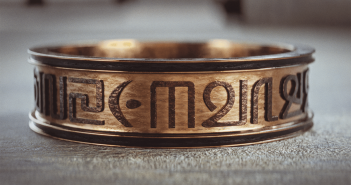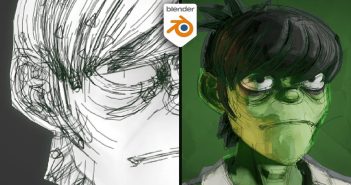INTRODUCTION
Hello! My name is Eirik Djuvsland, and I’m a self-taught 3D artist from Norway.
I started learning Blender 3 years ago. My projects are usually focused on classical, fantasy, or sci-fi architecture.
INSPIRATION
The idea for the Greek-style pool scene came while I modeled the columns. I usually model assets for my asset library in between renders when I’m trying to come up with a new idea. Then I used Pinterest to gather references that I added to PureRef. I ended up with a lot, but here are some key ones:
MODELING
When modeling the Corinthian columns, I started with the corners like this:
Then, I made the support under the corner piece and in the middle using the same method. I made the leaf shape using a plane with loop cuts, along with subdivision, solidify, and bevel modifiers. I further shaped it using the proportional edit tool, bending and rotating it to fit the curvature of the pillar. Once I filled one side, I mirrored it over.
The jars are made with cylinders and proportional editing by extruding faces and beveling them.
Here are the models of the pool stairs and fence.
All the trees and plants I used are from the Botaniq addon. The statues are from Ian Huberts Patreon, and one from Sketchfab by user 3dhdscan.
TEXTURING
I used textures.com for the textures and adjusted the colors to make them more coherent with each other. The main marble texture is from this photo texture with a bump node in the normal input, and an ambient occlusion node with a dirt texture as the shadow.
I made multiple copies of the same texture with different ambient occlusion values to avoid overshadowing certain areas while strengthening others. The floor texture has ambient occlusion as well for more dirt buildup between the flowerbeds and the floor.
For the fake pool caustics, I split the glass tile material in two by loop cutting, one with it and one without.
I then adjusted the loop cut to align with the pool's shadow.
The water shader is from Max Hay's tutorial, Creating Realistic Water in Blender.
For the fake caustics, I used the help of Cartesian Caramel's tutorial, Easy Caustics in Blender!
LIGHTING
The lighting setup is pretty simple, using an HDRI from Poly Haven and a sun lamp. I use both for more control over the highlights and overall contrast of the render. The god rays are from an Ian Hubert tutorial on Patreon.
To increase shadows in the foreground, I used a cube around the camera. The brightness can be adjusted by scaling the cube or giving it a darker material.
COMPOSITING
I do most of the compositing in Photoshop, but add a little lens dispersion in Blender.
When rendering, I included a mist pass and an ambient occlusion pass. I combined these in Photoshop before I did color correction, and added a little grain in the camera raw filter.
Max Hay has a very good tutorial on Photoshop post-processing called, How To Edit Your Renders With Photoshop.
And that was it! Below are the final renders.
RENDER - Greek Pool
And here is the final result! Thank you for reading, and do follow my socials if you’d like. If you have any questions, I’m happy to answer.
About the Artist
Eirik Djuvsland is a self-taught 3D artist from Norway.


























3 Comments
Super insightful and well written. This will be of great help to a lot of people.
It’s mesmerising to see how you go from zero to a million thank you soo much for this guide, not only your talent speak volumes, but your commitment to help the community, elevates it to higher levels ❤️
i enjoy. best. good luck.